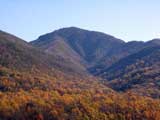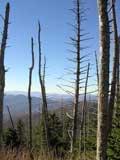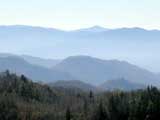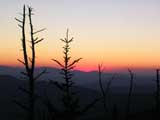|
P A R K S |
tj|tl|in|ca|st |
G R E A T S M O K Y M O U N T A I N S
N A T I O N A L P A R K
Tennessee/North Carolina BorderSunday, November 7, 2004
Park: #11
Established: 1934
Acres: 521,752
Annual Budget: $15,329,000 (FY 2004)
Visitors: 9,205,037 (FY 2004)
Highlights: Dramatic mountains, scenic valleys, over 10,000 species of flora and fauna, Appalachian Trail, Clingmans Dome, one of the largest protected areas in the eastern United States.
Location: Great Smoky Mountains National Park, Tennessee/North Carolina
Hours: Open year round, visitor center hours very with the season.
Phone: 865.436.1200
Park Admission: Free!
Link: Official Website
Top Pics: 30 Images
| Rating: |
 |
(5 max) |




Established by Congress in 1934, the road to creating Great Smoky Mountains National Park was a bumpy one at best. Lack of funding, squabbles between local, state, and federal governments, and the arrival of the Great Depression in 1929, were a few of the many obstacles that had to be overcome. Consisting of 6,600 individual tracts of land, this patchwork park comprises a whopping 814 square miles of scenic, mountainous wilderness.
One of the largest protected areas in the eastern United States, the park is home to over 10,000 species of animals and plants. Ranging in height from 875 to 6,642 feet atop Clingmans Dome, the flora and fauna varies widely as one ascends from valley to mountaintop. So much so, one would be hard pressed to find a better representative east of the Mississippi that mimics the majority of wildlife found throughout the eastern portion of the United States.
Forest covers approximately 95% of the park, of which roughly a quarter is old growth. Within the United States, aside from the Pacific Northwest and portions of Alaska, the Smoky Mountains receive America's greatest annual rainfall. Accumulating 55 inches in the valleys and 85 inches on the peaks per year, the park is normally a very humid place. This high humidity contributes to the area's namesake, however, the modern world has certainly contributed its fair share of pollution to further obscure distant landscape.
The Cherokee Indians lived in the Smokies and considered them an integral part of their overall homeland. However, white frontierspeople started settling into these parts in the 18th and early 19th centuries. During a dark time in American history, in 1830, all Indian tribes east of the Mississippi were ordered to move to what is now Oklahoma. Not all left, some hid out, and their descendants now live south of the park on the Qualla Reservation.
My visit to the park will be a short but sweet one. I have plans to drive up to Clingmans Dome to do a bit of hiking. On the way, I'm sure I'll get an eye full of beautiful scenery and heightened views. Come with me now as I enter into Great Smoky Mountains National Park. Visited by over 9 million people a year, that tells me there's got to be something for everyone here. And that includes you!
Description & Pics
<<<
Park
1
2
3
4
5
6
7
8
9
10
11
12
>>>
|